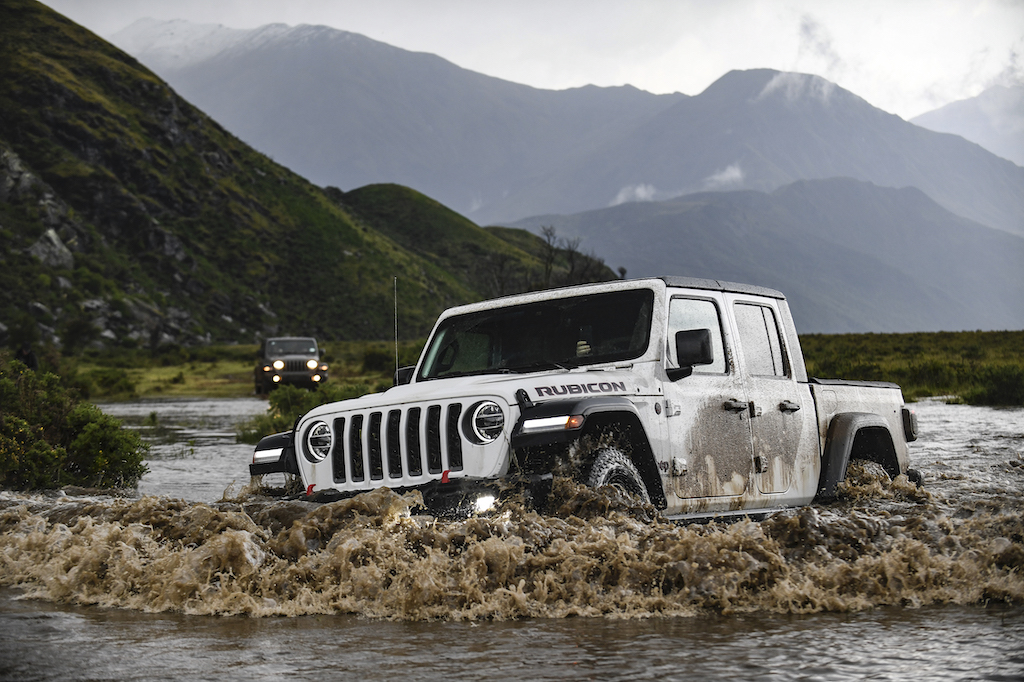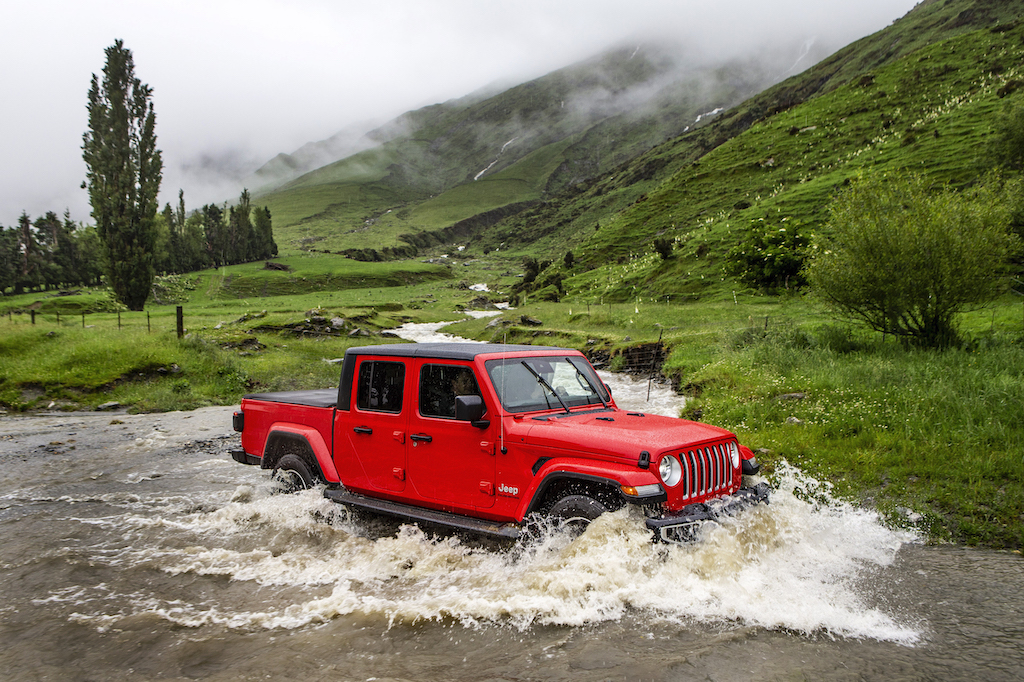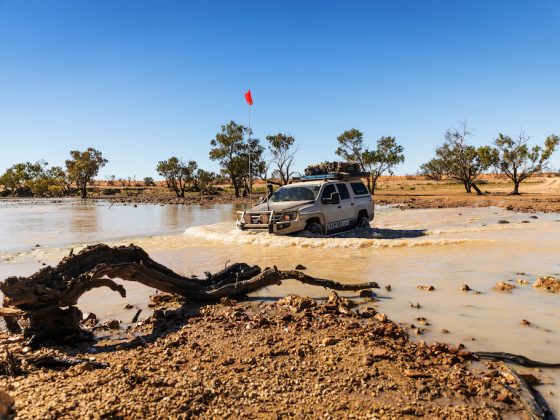Dave Morley’s first drive 2020 Jeep Gladiator Review with performance, ride and handling, practicality, safety and verdict.
2020 Jeep Gladiator Specifications
Price From $70,000 (est) Warranty Five years/100,000km Safety Not rated Engine 3.6-litre petrol V6 Power 213kW at 6400rpm Torque 353Nm at 4100rpm Transmission Eight-speed automatic Drive Part-time 4WD with low range Dimensions 5540mm long, 1857mm high; 1875mm wide; 3490mm wheelbase Turning Circle 13.7m Angles 40.7 degrees approach, 25 degrees departure, 18.4 degrees ramp-over Maximum Braked Towing Capacity 2721kg Payload 620kg Fuel Tank 100 litres Thirst Not available
With dual-cab utes selling like they come with a free beach-house, the new Gladiator is not only a new Jeep, but a big chance to do some serious business Down Under. Even recognising Jeep’s fairly dismal recent sales performance in this country, the Gladiator could be just the spark the brand needs to create some heat in showrooms.
But interestingly and something that may well make my previous two sentences redundant, the Gladiator represents possibly the last new Jeep to feature a diesel engine with the brand openly talking about an all-electric or petrol-hybrid future by 2022. Even more important than that switch to electrification is the news that Jeep Australia won’t actually commit to a diesel engine in the Gladiator in Australia. Ever.
So, will the Jeep Gladiator end up a non-starter here before it’s even officially gone on-sale? Maybe. And there’s still so much we don’t know about the Gladiator…and we’ve driven it. This first drive was at the international launch in New Zealand before Christmas and, while the Gladiator is on-sale in the US already and has been for some time, Jeep Australia wouldn’t actually confirm specifications. Yeah, it’s as frustrating for us as it is for you. Here’s the stuff we do know.
The Gladiator’s just a Wrangler with a tray, right?
Think new Wrangler with a chassis-stretch and a ute tub instead of a wagon body and you’re getting warm. The basic ladder-chassis design is the same and the suspension layouts are also carry-overs. The drivelines are the same (provided we actually get the turbo-diesel version, and that was no given at the time of the launch in New Zealand late last year) but we don’t actually know if we can expect both manual and automatic gearboxes. Yeah, Jeep Australia was being that vague about local specifications.
What we do know is we’ll get the Gladiator in two variants; the off-road-ready Rubicon and the slightly more road-oriented Overlander. Both versions conform, however, to Jeep’s Trail-Rated scoring system that guarantees their off-road credentials…a scoring system that remains a secret and doesn’t just mean the thing is capable of driving the Rubicon.
It’s how big?
The Gladiator measures 5539mm long with a wheelbase of 3490mm (the Wrangler measures 4700mm) and that makes it longer than the Ford Ranger, although the Gladiator’s tray measures 1531mm long, which is shorter than the tray on a dual-cab 79 Series – 180mm, and just shorter than a Ford Ranger’s tray – 1549mm long). Putting that into perspective, a LandCruiser 79 Series dual-cab is 5220mm long with a wheelbase measuring 3180mm. But it’s swings and roundabouts because the wheelbase on the Gladiator is much longer than the Ranger, measuring 3487mm compared with 3220mm although that knocks around the rampover angle.
Ground clearance is something else the Gladiator has on its side. According to Jeep, ground clearance runs from 253mm to 283mm on the Gladiator Rubicon (US-spec). And, unlike most other ute makers that fluff ground clearance claims, Jeep is usually measures accurately (to the bottom of the diff pumpkin).
The load height on the Gladiator’s tray is 885mm with the tailgate down and the width of the opening is 1270mm. There’s 1137mm between the wheel arches. And the Gladiator’s tray has some clever touches that show how Jeep thinks this thing will be used. For instance, the tailgate has been designed so it can be partially opened and locked in three different positions, with the width of the tray measured not in whether it’ll fit a pallet but in whether it’ll hold plywood sheets on top of the wheel arches and within the tray. There’s an assister spring on the tailgate to make it easy to open and close the tailgate. There are good ties downs nice and low (and the front ones fold and swivel) and there’s an optional spray-in tub-liner. There’s even an LED light for the tray.
Where the Gladiator might be better at holding its weight than its key competitors is that the tray is intended to get close to being 50:50 forwards and rear of the back axle.
The Gladiator’s other party trick is the ability to shed its clothes. The roof can be removed as several panels and there’s an optional soft-top that includes a soft tonneau. In Jeep tradition, the front windscreen also folds flat on to the bonnet and the doors are removable. Sadly, driving around without the doors is frowned upon by Australia authorities, despite an optional open-air door (a series of bars and voids that provides some (including side-impact) protection. Other body protection includes standard rock-rails that extend all the way to the rear, tow-hooks, bash-plates and, of course, that removable roof that makes the Gladiator the only convertible dual-cab ute around.
Wash and wear interior
Inside, it’s pretty much Wrangler including the info screen, tilt and height-adjustable steering column, switchgear and seats. The good news there is that the rear seat is especially good and way better than the majority of dual-cab utes out there. The driving position is okay but you’ll need to live without a driver’s footrest (or much space left of the brake pedal at all) and the upright windscreen and shallow glass areas make the interior feel smaller than it really is. Even so, this is no Tardis and the packaging shows that the Americans still have a bit to learn.
Nice touches include under-seat storage for the 60:40-split rear pew and, if you tick the option-box for Bluetooth connectivity, you’ll also get a weatherproof, removable speaker. The rest of the cabin is more or less hose-out, too, and there are loads of USB and 12-volt sockets scattered around the cabin. The switchgear for the mechanical stuff is all grouped in the centre of the dash, probably a function of the vehicle being built in both left and right-hand-drive. Either way, it’s all pretty clear even if there’s a fair bit going on in terms of your options for configuring the chassis.
How safe is this thing?
Oops: Here’s the elephant in the room. Based as it is on the Wrangler, there’s no real reason to suspect the Gladiator will fare much better than the former’s one-star score in independent crash-testing. Even worse is that now that ANCAP tests vehicles with a view to how much damage they cause (not just what damage they sustain) big, heavy vehicles like the Jeep might be even more marginalised in this department.
But other news is better. There are cameras at each end and the front one even has a washer system to clean the lens. Driver aids available include the latest stuff including blind-spot monitoring, rear cross-traffic alert, adaptive cruise and stability control. Unfortunately, autonomous emergency braking is not a thing for the Gladiator and so it’s unlikely to realise the recent three-star ANCAP update for Wrangler wagon.
What’s the performance like?
The only engine we know for sure Australia will get is the 3.6-litre Pentastar V6 petrol. It’s good for 213kW of power and 353Nm of torque in this, US-spec and, in our case, it’ll be teamed with the new eight-speed automatic. Like we said, the turbo-diesel was off the table as a discussion topic as was a manual gearbox.
The transfer-case ratio depends on whether you go for the Overland or Rubicon. In the former, the reduction ratio is 2.72:1 while the more bush-focussed Rubicon gets a 4:1 reduction. Drive modes include a setting called Off Road Plus which, in high-range gives you sand mode while punching the button in low-range will give you rock mode. Front and rear diff locks are standard, and the Rubicon version picks up the Wrangler’s decoupling sway bars which, when detached, give an extra 30 per cent wheel articulation.
What’s the suspension like?
The Gladiator retains live axles front and rear and while the front end is coil-sprung, so is the rear end, and is located by a five-link set-up that includes trailing arms and a Panhard rod. The coil springs have, however, taken a toll on payload which sits at 620kg and towing capacity which, at 2721kg, is well behind the established, leaf-sprung dual-cabs out there. The only real downside to the extra length is that the turning circle is now a Queen-Mary-spec 13.7 metres.
What’s it cost and what do you get?
This is the big unknown since our drive was an international first taste in US-spec, left-hand-drive vehicles rather than a full-on local launch. What we do know is that we’ll get the petrol V6 in automatic form and in Overland and Rubicon trim levels. What we don’t know is whether there’ll be a diesel option, a manual gearbox and a choice of Jeep’s two transfer-case layouts, Command-Trac or Rock-Trac.
On the upside, there’s good connectivity in the Gladiator and the convertible roof, full-length rock-rails and bash plates are all standard fitment. Which brings us to price, and if you thought Jeep was cagey on spec, then questions on the likely sticker had staffers heading for the bunker. But it would make sense that the Gladiator is something like a few grand more than a Wrangler which should see the tray-back range from around $60,000 to $70,000. Maybe.
What’s it like to drive on the road?
If there’s one big difference between the Gladiator and the Wrangler upon which it’s based, it’s ride quality. That’s surely all down to the extra wheelbase which places the passengers farther away from the rear axle, reducing pitch and bounce. It really is a major improvement. Of course, the steering that is deliberately slow for off-road work still feels pretty numb on the road and the live axles with their Panhard rods (rather than a Watts link) can contribute to a fair bit of bump-steer when you start hammering and yammering over corrugations. There’s also plenty of unsprung weight in evidence, but hey, if you wanted a sports car, you’ve come to the wrong place.
The engine is smooth and revs pretty well – although things are more or less all over by the time 5000rpm has registered on the tacho – and there’s even a subtle exhaust note to work with. But even with eight ratios to choose from in the auto box, the engine still seems to struggle when climbing hills at highway speeds. It’s nothing more complicated than a lack of Newton-metres at low revs and although the tranny will eventually shift down two or three ratios and perk things up, it’s often too late and you’ve already started to lose forward velocity. Certainly, we’d have loved to sample the turbo-diesel in the Gladiator but that just wasn’t to be. And may not be on the agenda at all, remember.
What’s it like off the road?
The instant you lock the diffs and head across the lava-field, you just know the Gladiator is going to take anything you can chuck at it. You can feel the huge amount of suspension flex on tap and even though the steering ratio remains slow, it starts to make sense in terms of its feel and weight.
The auto gearbox is pretty quick to respond to your inputs and although there’s hill-descent fitted, low-first in the Rubicon (the only variant we got to sample) is as crawler-gear as you’ll ever need. When the rocks started to get bigger and the ruts deeper, a quick stab at the sway bar switch and you suddenly had a lot more axle droop available, although even with that, the Gladiator is so long, you’re a chance to give the rock-rails a bit of a massage. Fine by us. Meantime, even in that sort of terrain, the bash plates never saw action. What you might discover, though, is that hairpin turns in the scrub might take a couple of bites thanks to the huge length of the thing and the equally vast turning circle
Crawling along across a line of boulders also takes your mind off any lack of torque from the petrol V6. Fundamentally, there’s so much gearing for the taking that it’s just not an issue, and at times, you’re actually thankful for the engine’s ability to rev since it means you can hold a lower gear between obstacles and not be caught in the wrong ratio when the 2300kg of the Rubicon starts to feel the gravity. The seats offer enough support but still allow you to peer around the A-pillars, but damn, a left-foot rest to steady yourself over lumpy terrain would be a nice touch.
So, where’d we drive it?
Leaving Queenstown on New Zealand’s south island on the bitumen, we headed north-west through Cadrona before turning due north, through the town of Wanaka and onwards until the bitumen ran out. From there, we followed a gravel road up a glacial valley until we approached Mount Aspiring and the national park named after it. Eventually we made our way on to a private property where a short, but very technical, off-road course had been made available to us. This was tackled pretty much all in second-low and the tracks were rough, slippery in places and made up in parts of very large, sticky-outy rocks that really tested the suspension travel.
Anything go wrong?
Mainly the weather. Torrential rain had made the road through Wanaka (the lake was actually flooding the town) impassable until they day we were due to tackle it, so there was even a bit of water fording to be done. Made us wonder why the Gladiator doesn’t come standard with a snorkel, though.

























